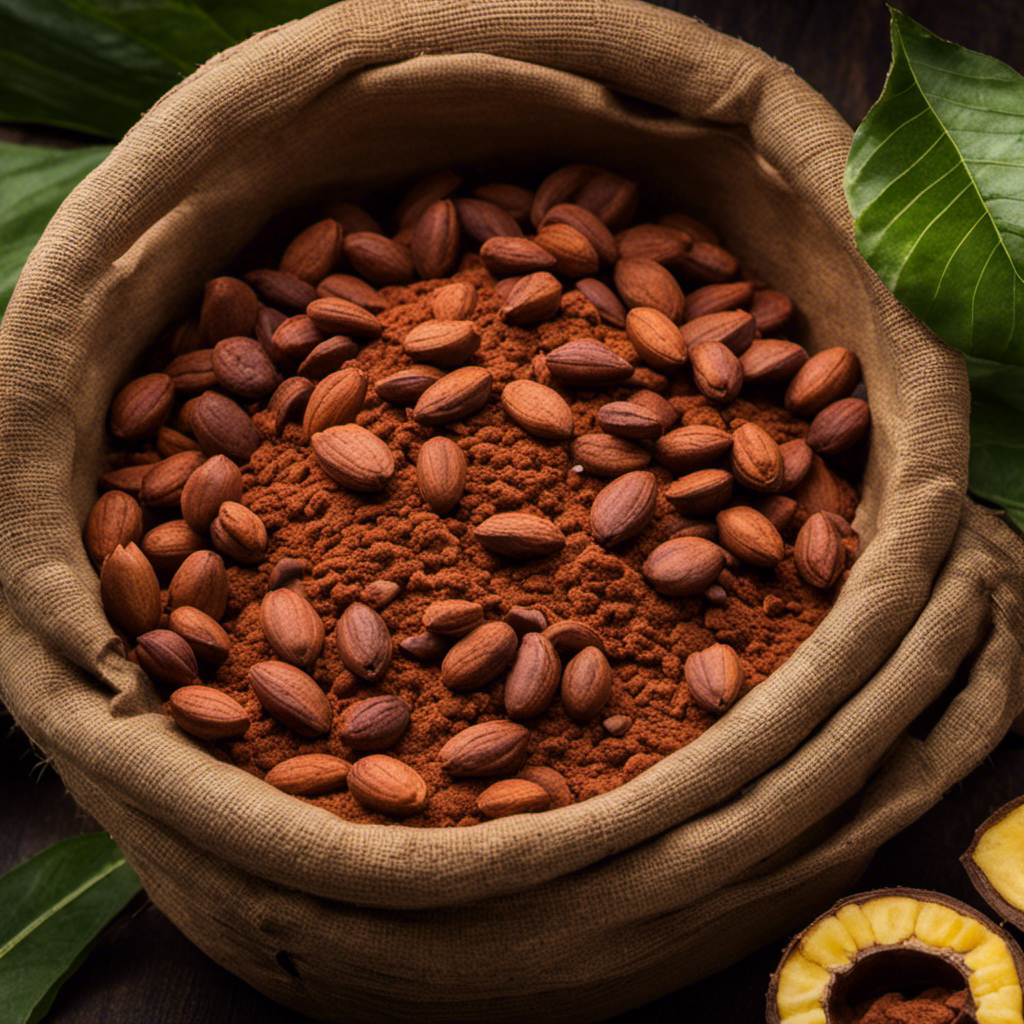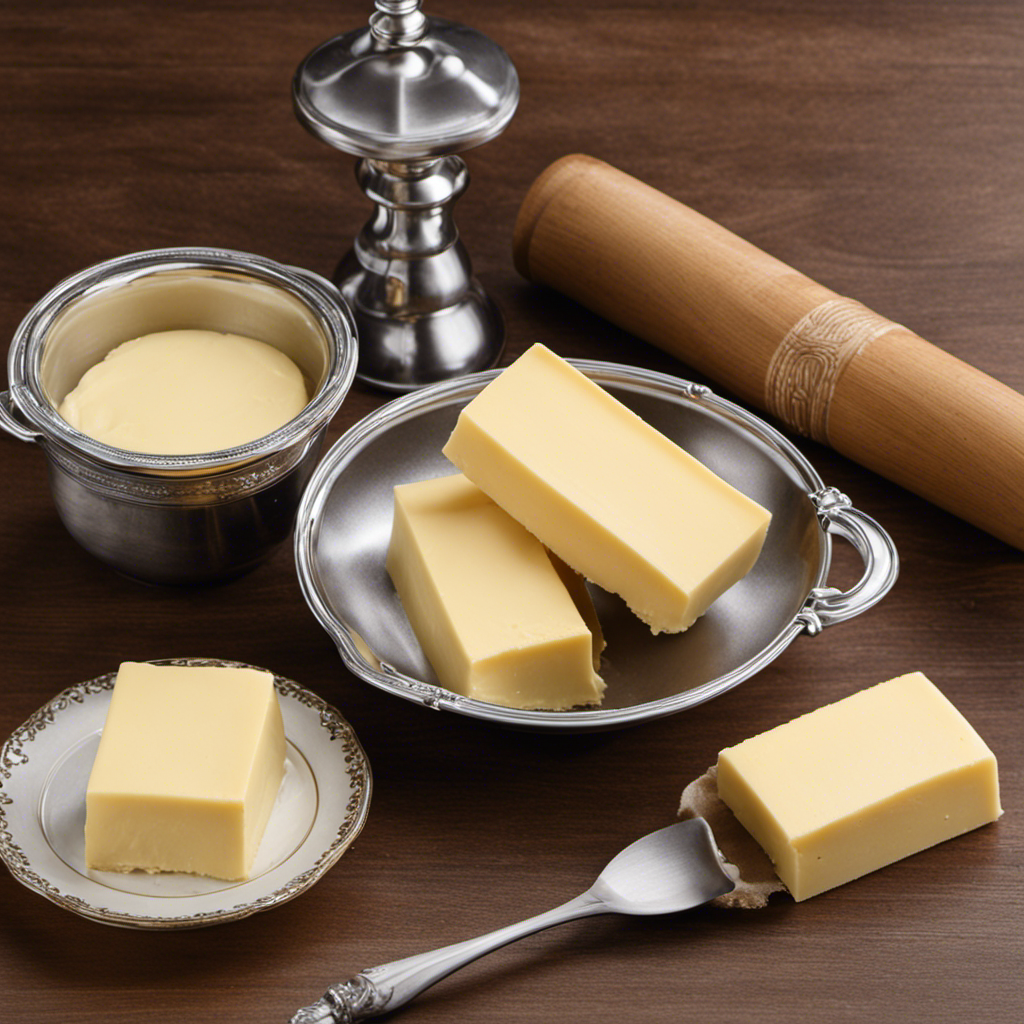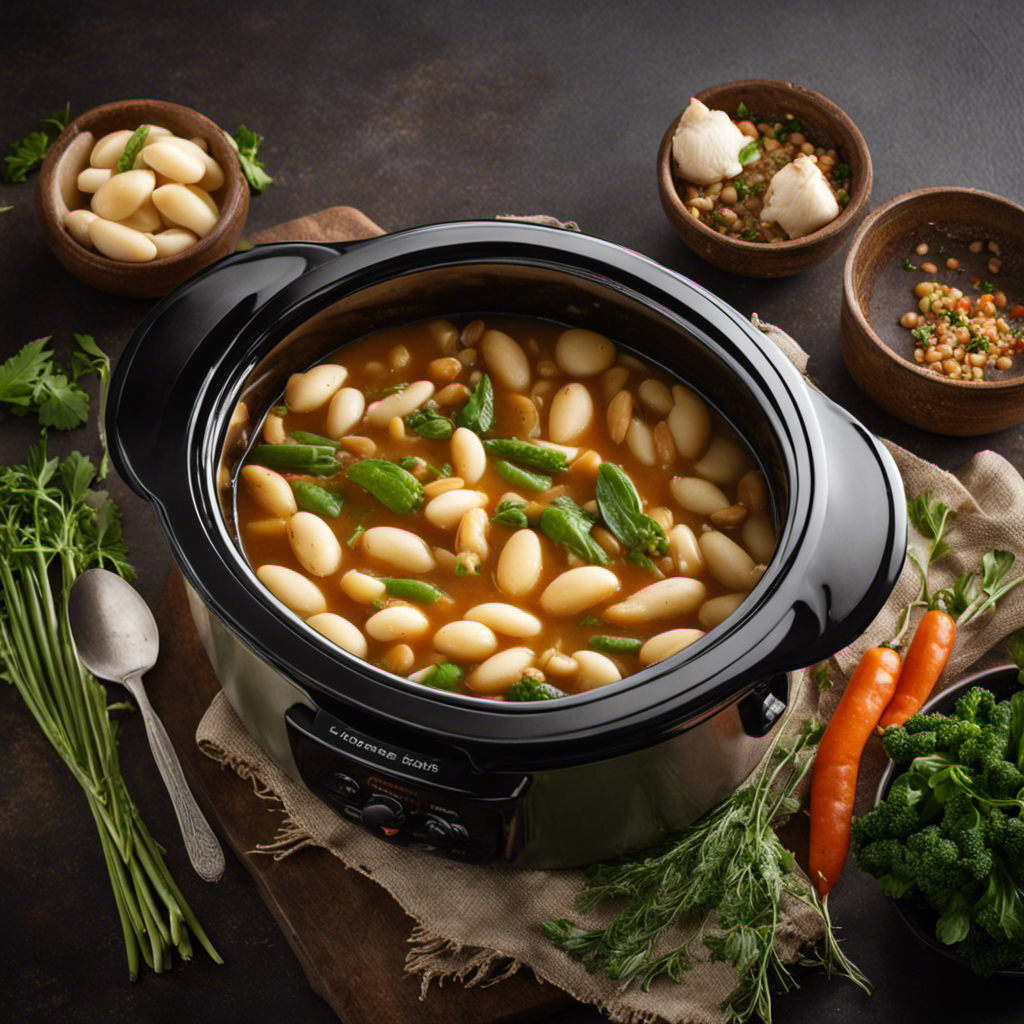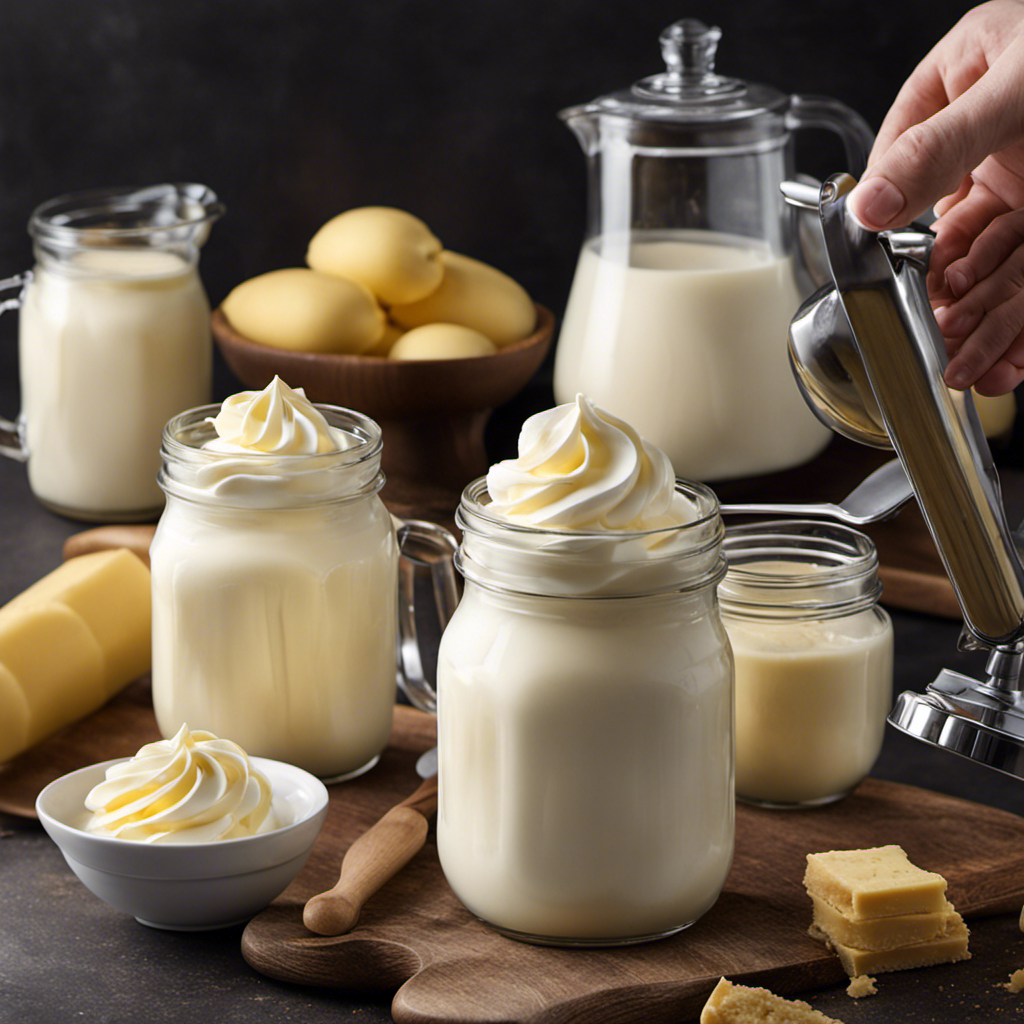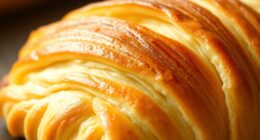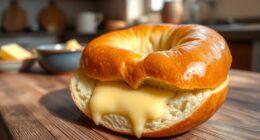I’ve always been intrigued by the process of creating cocoa butter. It’s remarkable how a basic bean can be turned into this luxurious, velvety ingredient that enhances the flavor and texture of our beloved treats.
The journey starts with the careful harvesting of cocoa beans, followed by a series of precise steps including fermentation, drying, roasting, grinding, and purification. Each step plays a crucial role in extracting the pure, velvety goodness that is cocoa butter.
Join me as we delve into the scientific complexities and technical intricacies behind the creation of this culinary marvel.
Key Takeaways
- Cocoa bean cultivation involves sustainable practices such as selecting an ideal planting site and implementing sustainability practices.
- Proper handling and hygiene are crucial in maintaining purity, preventing contamination, and preserving the quality of cocoa butter.
- Roasting and grinding techniques, such as precise temperature control and stone grinding, play a significant role in flavor formation and preserving natural flavors and properties.
- Pressing, separating, and purifying cocoa butter involve various techniques such as hydraulic pressing, solvent extraction, filtration, degumming, deodorization, and purifying techniques to refine and purify cocoa butter.
Cocoa Bean Harvesting
To make cocoa butter, you’ll first need to understand how cocoa beans are harvested.
Cocoa bean cultivation involves sustainable practices to ensure the longevity of the crop. The process begins with the careful selection of the planting site, which should provide the ideal conditions for cocoa trees to thrive.
Once the trees are mature, the cocoa pods are hand-harvested to ensure that only ripe pods are collected. This requires skilled laborers who can identify the optimal ripeness of the pods.
After harvesting, the pods are opened, and the cocoa beans are removed. These beans are then fermented and dried to develop the desired flavor profile.
The sustainability practices implemented in cocoa bean cultivation include agroforestry techniques, water conservation, and responsible use of fertilizers and pesticides. These practices aim to maintain the ecological balance and protect the biodiversity of cocoa-growing regions.
Fermentation Process
During fermentation, cocoa beans undergo a natural process that enhances their flavor and aroma. As a food scientist, I can explain the precise steps involved in making cocoa butter.
After harvesting, the cocoa beans are placed in fermentation boxes, where microbial activity occurs. This microbial activity is crucial for the fermentation process. The beans are left to ferment for several days, with periodic turning to ensure even fermentation. The temperature and humidity are carefully monitored to create optimal conditions for microbial growth.
The fermentation process not only helps to develop the unique flavor compounds in cocoa beans but also affects the chemical composition, breaking down proteins and carbohydrates. This breakdown is essential for later steps in cocoa butter production, such as extraction and refining.
Quality control measures are implemented to ensure that the fermentation process is consistent and meets the desired standards for cocoa butter production.
Drying and Sorting
Cocoa bean processing is a crucial step in the production of cocoa butter. It involves several precise techniques and quality control measures.
As a food scientist, I understand the importance of proper handling during this process to ensure the highest quality end product.
Cocoa Bean Processing
After the cocoa beans are harvested, they are fermented and dried before being roasted. This is a crucial step in cocoa butter production as it helps develop the characteristic flavors and aromas of the final product.
Here is a breakdown of the cocoa bean processing:
-
Fermentation: The beans are placed in large heaps or fermentation boxes where they undergo microbial fermentation. This process helps break down the pulp surrounding the beans and initiates biochemical reactions that contribute to the development of cocoa flavors.
-
Drying: Once fermented, the beans are spread out to dry in the sun or using specialized drying equipment. Drying removes excess moisture and reduces the risk of mold growth.
-
Roasting: The dried beans are then roasted to further develop their flavors and aromas. Roasting also helps remove any remaining moisture and activates enzymes responsible for cocoa butter formation.
Cocoa butter production is a complex process that involves various scientific principles and techniques. The extraction methods, refining processes, and the role of enzymes and chemicals play a crucial role in the production of high-quality cocoa butter.
Now that we have covered the cocoa bean processing, let’s move on to the next section where we will discuss the important quality control measures in cocoa butter production.
Quality Control Measures
To ensure the production of high-quality cocoa butter, you need to implement rigorous quality control measures throughout the entire process. As a food scientist, I understand the importance of documentation and precise procedures in cocoa butter production.
Quality control procedures play a crucial role in maintaining consistency and ensuring that the final product meets the desired standards. Throughout the production process, various quality control measures must be in place.
This includes monitoring and controlling the temperature during the extraction and refining processes to prevent any degradation of the cocoa butter. Regular testing for moisture content, acidity, and fat content is also essential. Additionally, proper storage conditions and cleanliness of equipment are crucial to avoid any contamination.
Importance of Proper Handling
Proper handling is crucial in ensuring the quality and integrity of the final product, which requires strict adherence to hygiene and safety protocols.
As a food scientist, I understand the importance of proper storage and preventing contamination in the production of cocoa butter. Here are three key reasons why it is essential:
-
Maintaining purity: Cocoa beans must be stored in a clean and dry environment to prevent the growth of mold or bacteria. Any contamination can affect the flavor and aroma of the cocoa butter.
-
Avoiding oxidation: Cocoa beans are susceptible to oxidation, which can lead to rancidity. Proper handling techniques, such as storing the beans in airtight containers and minimizing exposure to air, help preserve the quality of the cocoa butter.
-
Preventing cross-contamination: During the extraction and refining processes, it is crucial to prevent cross-contamination with other ingredients or allergens. Strict separation and cleaning procedures ensure the purity and safety of the final cocoa butter product.
Roasting the Cocoa Beans
When it comes to roasting cocoa beans, the temperature and duration play a crucial role in shaping the flavor profile of the resulting cocoa butter.
As a food scientist, I will delve into the scientific aspects of this process, exploring the chemical reactions, temperature requirements, and quality control measures involved.
Temperature and Roasting Duration
The temperature and roasting duration greatly affect the production of cocoa butter. As a food scientist, I understand the importance of precise temperature control and timing in achieving the desired flavor and quality of cocoa butter. Here are three key points to consider:
-
Roasting techniques: Different roasting techniques, such as low and slow or high and fast, can have varying effects on the flavor development of cocoa beans. The temperature and duration of roasting play a crucial role in determining the intensity and complexity of the cocoa flavor.
-
Maillard reaction: During roasting, the Maillard reaction occurs, resulting in the browning and flavor formation of cocoa beans. This reaction is temperature-dependent, and careful control of the roasting parameters is necessary to achieve the desired flavor profile.
-
Quality control: Monitoring the temperature and roasting duration is essential to ensure consistency and uniformity in the production of cocoa butter. Regular testing and analysis help maintain the desired flavor and quality standards.
Understanding the impact of temperature and roasting duration on cocoa butter production is crucial for achieving the desired flavor profile.
Impact on Flavor Profile?
Achieving the desired flavor profile of cocoa butter depends on carefully controlling the temperature and roasting duration. As a food scientist, I understand the importance of these factors in creating a high-quality cocoa butter.
The temperature and roasting duration impact the flavor by influencing the chemical reactions that occur during the process. The Maillard reaction, for example, takes place when the temperature reaches a certain level, resulting in the development of desirable flavors and aromas. However, it is crucial to monitor the temperature closely to prevent the cocoa butter from becoming over-roasted, which can lead to a burnt or bitter taste.
Additionally, the texture of cocoa butter can also be affected by temperature and roasting duration. Proper control of these variables ensures that the cocoa butter has a smooth and creamy texture.
From a nutritional standpoint, cocoa butter contains healthy monounsaturated fats, which can have positive effects on heart health.
Grinding the Cocoa Nibs
To grind the cocoa nibs, you’ll need a grinder or food processor. Grinding the nibs is an essential step in cocoa butter production as it helps release the fat from the nibs.
Here are three grinding techniques commonly used:
-
Stone Grinding: Traditional method involving grinding cocoa nibs between two stone plates. This process ensures gentle grinding, preserving the natural flavors and properties of the cocoa butter.
-
Ball Milling: Involves using steel balls in a rotating drum to grind the nibs into a fine paste. This method is more efficient and can produce smoother cocoa butter.
-
Roller Refining: A modern technique where the nibs are passed through multiple roller mills to achieve the desired particle size. This method provides precise control and consistency in grinding.
Grinding the cocoa nibs is crucial to expose the cocoa butter and create a smooth texture. It allows for better extraction of fats and contributes to the unique properties of cocoa butter, such as its melting point and crystallization behavior.
Pressing the Cocoa Liquor
After grinding the cocoa nibs, the next step in the production of cocoa butter is pressing the cocoa liquor. This process involves the application of pressing techniques to extract the cocoa butter from the cocoa mass.
The cocoa liquor is placed in a hydraulic press, where pressure is applied to separate the fat from the solids. The cocoa butter, being a fat, is forced out while the cocoa solids remain behind.
The pressing techniques used can vary, including hydraulic pressing or screw pressing, depending on the desired yield and quality of the cocoa butter. The properties of cocoa butter, such as its melting point and texture, are largely influenced by the pressing process.
It is important to carefully control the pressure, temperature, and time during pressing to obtain cocoa butter with the desired characteristics. Quality control measures, such as monitoring the moisture content and acidity, are also implemented during this stage to ensure the production of high-quality cocoa butter.
Separating Cocoa Butter From Cocoa Powder
When it comes to extracting cocoa butter, there are various methods that can be employed. One common method is hydraulic pressing, where the cocoa liquor is subjected to high pressure to separate the cocoa butter from the cocoa solids.
Another method is solvent extraction, where a solvent such as hexane is used to extract the cocoa butter from the cocoa liquor.
As for the uses of cocoa powder, it is widely used in baking and confectionery products as a flavoring agent and coloring agent. It is also used in the production of chocolate and chocolate-based beverages.
Extraction Methods for Cocoa Butter
You can extract cocoa butter using various methods such as hydraulic pressing or solvent extraction.
In hydraulic pressing, the cocoa nibs are ground into a paste and then pressed to separate the cocoa butter from the cocoa solids.
Solvent extraction involves using food-grade solvents to dissolve the cocoa butter from the cocoa powder. The cocoa butter is then separated from the solvent through a refining process.
During this process, the cocoa butter undergoes several stages of filtration and purification to remove impurities and improve its quality. Quality control measures are implemented to ensure that the cocoa butter meets the required standards.
The extraction techniques and refining process are crucial in obtaining high-quality cocoa butter for various applications.
Now, let’s move on to explore the uses of cocoa powder.
Uses of Cocoa Powder
One of the most popular uses of cocoa powder is in baking delicious chocolate desserts. Cocoa powder is the result of processing cocoa beans, which are roasted and ground into a fine powder.
As a food scientist, I can tell you that cocoa powder is not only a key ingredient in desserts, but it also offers numerous health benefits. It is rich in antioxidants, which can help reduce the risk of heart disease and improve brain function. Additionally, cocoa powder contains minerals such as magnesium and iron, which are essential for maintaining good health.
Its uses extend beyond desserts as well, as it can be used in smoothies, hot cocoa drinks, and even savory dishes like mole sauce.
Now, let’s delve into the process of purifying the cocoa butter.
Purifying the Cocoa Butter
To purify cocoa butter, the impurities are removed through a process called filtration. This is done to ensure the final product is of high quality and free from any unwanted substances.
Here are three purifying techniques used in the refining process of cocoa butter:
-
Filtration: The cocoa butter is passed through a series of filters, which physically remove any solid impurities or unwanted particles.
-
Degumming: This step involves treating the cocoa butter with water or citric acid to remove any phospholipids present, which can affect the flavor and stability of the butter.
-
Deodorization: To eliminate any undesirable odors or flavors, the cocoa butter is subjected to high temperatures under vacuum conditions. This process helps remove volatile compounds and enhances the overall quality of the butter.
Through these purifying techniques, the cocoa butter is refined and purified, resulting in a smooth and high-quality product that is widely used in the chocolate and confectionery industry.
Cooling and Solidifying the Cocoa Butter
After the purification process, the cocoa butter is cooled and solidified to achieve the desired texture and consistency. Cooling techniques play a crucial role in the production of cocoa butter as they help to control the crystallization process.
The melted cocoa butter is slowly cooled down, usually using a cooling tunnel or refrigeration system, to promote the formation of stable crystals. This solidification process is carefully monitored to ensure that the cocoa butter solidifies evenly and without any defects. Maintaining the right temperature during cooling is essential to achieve the desired properties of cocoa butter.
Proper solidification is crucial as it affects the texture, melting point, and overall quality of the final product. Once the cocoa butter has solidified, it is ready for packaging and storing, ensuring its freshness and preserving its unique characteristics.
Transitioning into the next section, let’s now explore the important aspects of packaging and storing cocoa butter.
Packaging and Storing Cocoa Butter
When packaging and storing cocoa butter, be sure to choose airtight containers to preserve its freshness and prevent any potential spoilage. Proper packaging techniques play a crucial role in maintaining the quality and extending the shelf life of cocoa butter.
Here are three essential tips for packaging and storing cocoa butter:
-
Use opaque containers: Cocoa butter is sensitive to light and heat, which can cause it to degrade. Opt for opaque containers that can shield the butter from light exposure, preserving its color and flavor.
-
Seal tightly: Airtight containers prevent any moisture or air from entering, which can lead to rancidity. Ensure the lid or closure is tightly sealed to maintain the freshness and prevent oxidation.
-
Store in a cool place: Cocoa butter should be stored in a cool and dry environment, away from direct sunlight and heat sources. This helps maintain its stability and prevent any melting or softening.
Utilizing Cocoa Butter in Various Industries
Using cocoa butter in various industries has become increasingly popular due to its versatility and numerous benefits. As a food scientist, I have witnessed the growing demand for cocoa butter in the beauty and food sectors. In the table below, I have outlined some of the key applications of cocoa butter in these industries:
| Beauty Products | Food Recipes |
|---|---|
| Moisturizers | Chocolate |
| Lip balms | Desserts |
| Body lotions | Baked goods |
In beauty products, cocoa butter is utilized for its moisturizing properties and ability to improve skin elasticity. It is commonly found in lip balms, body lotions, and moisturizers. In the food industry, cocoa butter is incorporated into various recipes to enhance the flavor and texture. It is commonly used in chocolate production, as well as in desserts, baked goods, and confections. The unique chemical composition of cocoa butter, with its high content of saturated fats, gives it the ability to provide a smooth and creamy texture to these products.
Frequently Asked Questions
How Long Does the Cocoa Bean Harvesting Process Typically Take?
The cocoa bean harvesting process typically takes several days. It involves carefully picking ripe cocoa pods from trees, removing the beans, fermenting them, and then drying them in the sun.
What Are the Different Methods Used for Drying and Sorting Cocoa Beans?
When it comes to drying methods and sorting techniques for cocoa beans, there are several options available. These processes play a crucial role in ensuring the quality and flavor of the final cocoa butter product.
How Does the Roasting Process Affect the Flavor and Aroma of Cocoa Beans?
The roasting process brings out unique flavors and aromas in cocoa beans, enhancing the overall taste of cocoa butter. It’s fascinating how heat transforms the chemistry of the beans, resulting in a delightful sensory experience.
What Are the Different Ways Cocoa Nibs Can Be Ground to Produce Cocoa Mass?
To produce cocoa mass, cocoa nibs can be ground using various methods. This grinding process creates cocoa paste, which is then further processed to extract cocoa butter.
Can Cocoa Butter Be Used in Industries Other Than the Food and Cosmetic Industries?
Yes, cocoa butter can be used in various industries beyond food and cosmetics. It has applications in pharmaceuticals, personal care products, and even in the manufacturing of certain industrial lubricants. There are also cocoa butter substitutes available.
Conclusion
To conclude, the process of making cocoa butter involves several precise steps and specific details.
From harvesting and fermenting the cocoa beans to grinding and purifying the cocoa nibs, each stage requires careful attention to ensure quality.
The cooling and solidifying of the cocoa butter is crucial, as is the packaging and storing process.
Cocoa butter finds its use in various industries due to its unique properties.
As a food scientist or food technologist, it is essential to understand the scientific aspects and technical language involved in cocoa butter production.
